Compliance
DOT Compliance Solutions
DOT driver compliance solutions to improve management, training, and help meet DOT requirements.

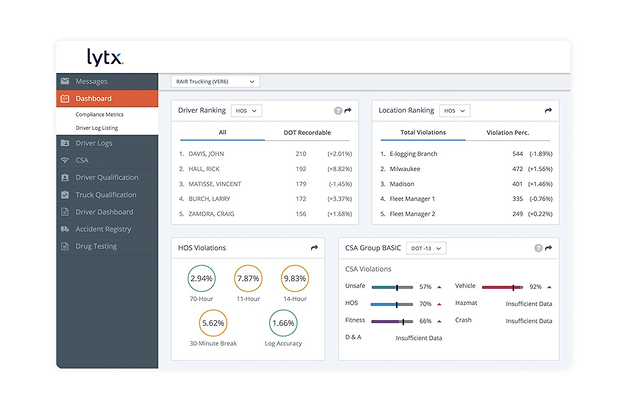
Customizable DOT compliance software and ELD solutions to meet your evolving needs
Learn More About Our DOT Compliance and ELD Solutions
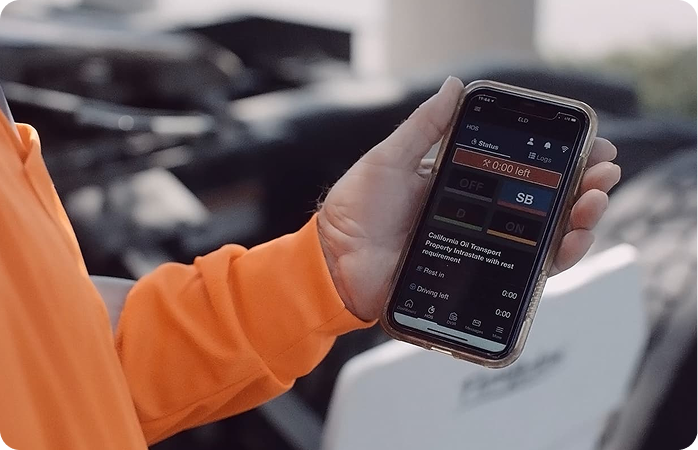
Electronic logging devices (ELD)
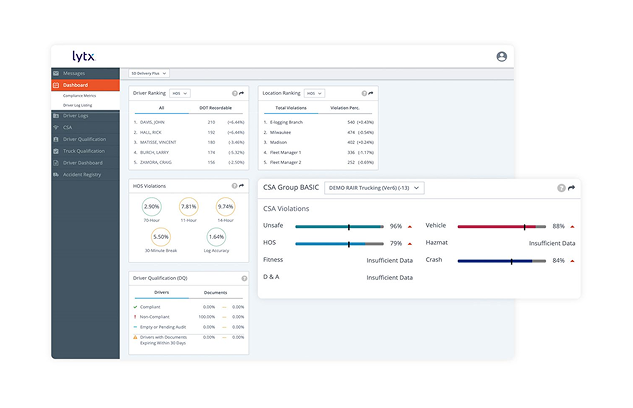
DVIR management
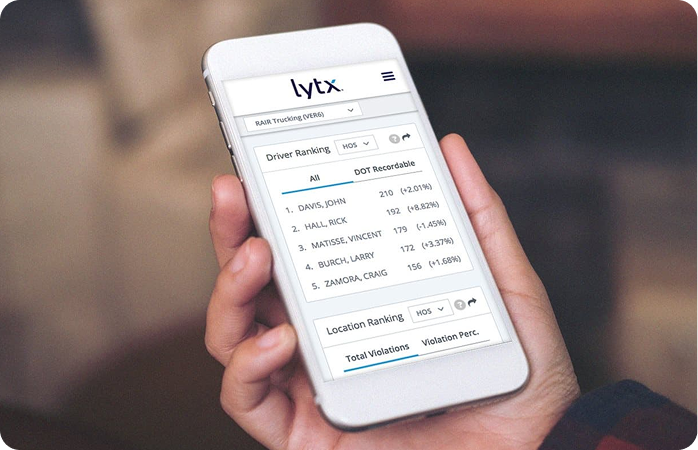
Hours of service (HOS) management
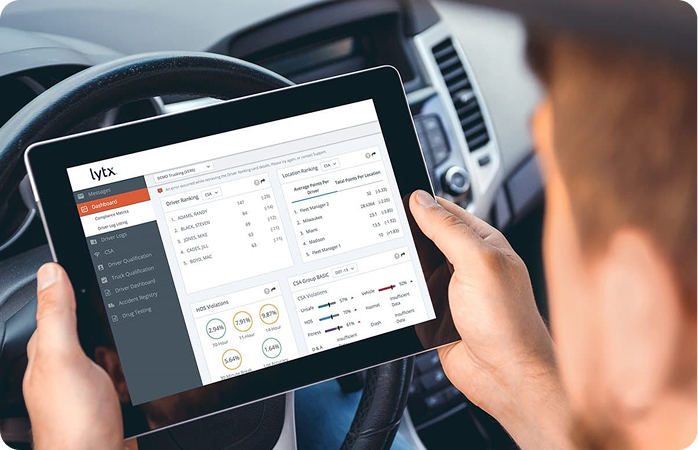
Audit driver qualification files
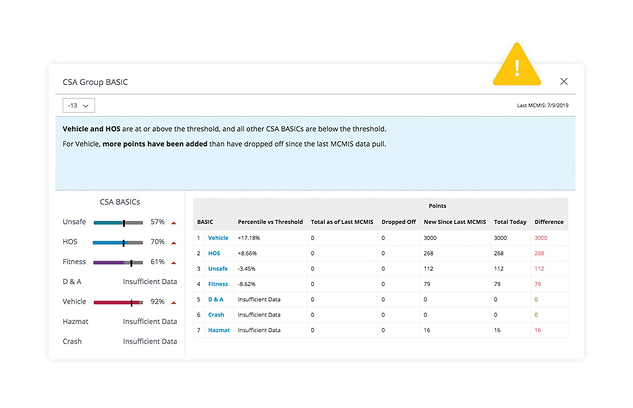
CSA data analysis


"[Lytx] technology, with all the ways we’ve learned to use it, has become such a valuable tool. If there was one technology I could have had throughout my 32 years in the transportation business, [Lytx] would be it. It’s another set of eyes. It’s proof. It protects the driver. And it protects the company."
Jerry Welsch
Safety Manager, A.D. Transport Express
Frequently Asked Questions
Simply put, Department of Transportation (DOT) compliance is the act of making sure all DOT rules, laws, and regulations are being met by your drivers, your vehicles, and your company. If your business has commercial vehicles on the road, ensuring DOT compliance is critical to your success.
What are the rules you’ll need to know to be DOT compliant?
The DOT compliance standards address areas of worker and public safety. DOT compliance for trucking companies aims to prevent commercial motor vehicle-related injuries and deaths on US highways. Education, awareness, compliance, and enforcement are all key factors in meeting this aim.
Some specific DOT requirements include maintaining a regular maintenance schedule, filling out driver vehicle inspection reports, monitoring the number of hours on the road, and more. DOT compliance companies also need to keep up-to-date driver qualification files on all their drivers. These files contain pertinent information on the drivers’ ability to operate a commercial vehicle safely.
Here are some key rules about DOT compliance you need to know:
- Annual inspection: The FMCSA mandates a commercial motor vehicle inspection to be completed every 12 months by a qualified inspector. An Annual Periodic Vehicle Inspection Report must be signed off before the motor vehicle carrier can proceed to use it.
- Driver Vehicle Inspection Reports: At the end of each workday, drivers must go through a complete vehicle inspection. Items they need to inspect include brakes, steering mechanism, tires, horn, emergency equipment, and more. The driver will record any deficiencies or issues identified in the report. Corrective actions need to be completed before the vehicle can be operated.
- Hours of Service: The hours of service regulations dictate limits to daily driving hours for commercial motor vehicle drivers. It also includes rest break requirements for drivers driving for long periods of time.
- Driver Qualifications: Companies must keep a Driver Qualification File (DQF) for each of their drivers. A DQF ensures drivers are fit to operate commercial motor vehicles and are compliant with DOT standards. Driving history, violations, driver’s license, and medical examiners certificate are just some of the documents required in the DQF. Companies must also conduct drug and alcohol testing for all drivers prior to employment, as well as randomly testing during employment.
DOT compliance helps ensure the safety of your drivers and all other people on the road. Failure to comply with DOT regulations can result in penalties, and even prevent your company from conducting core business operations.
Businesses and drivers that aren’t DOT compliant increase their liability and risk. Most insurance claims are void in cases where businesses, vehicles, or drivers fail to meet DOT regulations. Failure to maintain current compliance can also take drivers off the road and result in lost jobs.
The Federal Motor Carrier Safety Administration mandates certain commercial vehicles traveling interstate to be DOT compliant.
Namely, there are four factors that would subject you to DOT regulations:
- The gross vehicle weight rating or the combination weight rating of your vehicle is greater than 10,001 lb.
- The vehicle is used to transport between 9-15 people for monetary compensation.
- The vehicle is used to transport 16 or more people.
- The vehicle is used to transport hazardous materials.
Trucking companies, waste management businesses, transit organizations, and various construction companies are examples of industries subject to these federal regulations.
Note, while the above requirements apply to interstate travel, several states mandate DOT compliance for intrastate travel as well. Inquire with your particular state agency when traveling within state borders to ensure you are DOT compliant.
Ensuring DOT compliance in your fleet can be a significant undertaking. Here are some tips to keep your fleet compliant:
- Keep a copy of FMCSA regulations at the office and with every driver.
- Confirm each commercial motor vehicle is marked with its DOT registration number.
- Keep up with pre- and post-trip inspections.
- Maintain and document a maintenance program for your entire fleet.
- Take corrective action for any vehicle deficiencies found in reports.
- Track the number of hours your drivers have been on the road.
- Document any incidents or accidents your vehicles may have been part of.
- Ensure all paperwork is complete and up-to-date.
- Utilize DOT compliance services or software to maintain compliance as well as prepare for a potential DOT compliance audit.
Not only are companies responsible for DOT compliance, drivers also play a role in being compliant. Below is an essential list of tips to ensure that drivers are compliant as well:
- Ensure drivers have a current copy of all the FMCSA regulations and that they’ve signed off in agreement to follow all rules.
- Prepare drivers for commercial licensing. A commercial license is required for DOT compliance. This means the driver must pass three tests: Vehicle Inspection Test, Basic Controls Test, and Road Test.
- Companies must acquire a record of violations (i.e. a list or certificate) from each driver, even if they have a clean record.
- A medical examiner must conduct a physical examination for each driver and provide a certificate.
- Administer drug and alcohol testing for all drivers prior to employment. Conduct random testing during employment, as well.
- Keep driver DQF up-to-date and ensure all required documents are on file.
The main DOT regulations for truck driver employees are:
-
Must obtain and maintain a driver’s license (state-by-state requirements apply)
-
Must be at least 21 years old and have a CDL (commercial driver’s license) to operate trucks over 26,000 lbs cross state lines
-
Must have at least a 70-degree field of vision
-
Must have at least 20/40 vision with or without corrective lenses
-
Must not be colorblind and able to recognize and distinguish among traffic control signals and devices showing red, green, and amber colors
-
Must be able to read and speak English well enough to communicate with police, prepare reports, and understand road signs
-
Must pass the DOT written exam
-
Must pass a physical exam every two years
-
Must follow Hours of Service regulations
This list isn’t exhaustive and doesn’t include specialty regulations like transporting hazardous materials or random drug and alcohol testing. Some of the requirements are self-explanatory, while others are a bit more complex, which is why many fleets use compliance software to help them manage DOT compliance files and issues with their employees.
DOT compliance services help automate and streamline DOT compliance audits and processes. These services help businesses save time, avoid penalties, and keep qualified drivers on the road.
The most effective DOT compliance services will enable you to:
-
Manage hours of service files to audit driver logs and supporting documents
-
Simplify driver qualification file management
-
Provide insight into CSA violations
-
Streamline electronic and paper driver vehicle inspection reports (DVIRs)
-
Monitor and log information from electronic logging devices (ELD)
-
Review and manage dash cam footage
Effective DOT compliance audit solutions can help businesses save time and money. Analytics reports can identify compliance issues so they can be addressed before they result in a penalty.
While DOT regulations can be quite complex and difficult to track, companies and businesses are nevertheless responsible for compliance. However, DOT compliance help from resources like DOT compliance consultants or DOT compliance software like Lytx is available to aid businesses in keeping up with the regulations.
The repercussions for noncompliance with DOT regulations are serious. Consequences for not complying can include hefty fines, revocation of business and vehicle licenses, and injuries or deaths.

Interested in pricing?
Combine Services to Build a Comprehensive Fleet Solution
Learn More About Ensuring Compliance For Your Business
The Lytx Difference
Service
Our team is invested in your success. We surround you with a team of technical, data, and industry experts to create a program that helps your company achieve extraordinary results.
Leadership
With a more than 27-year track record of real-world experience in delivering results, our award-winning technology, program, and service is with you every step of the way. We bring the strength and financial stability to be with you for the long haul.
Innovation
Our machine vision and artificial intelligence are powered by the most robust driving database of its kind with 311 billion miles and counting. Through Lytx Lab, we harness client-focused innovation to create solutions that deliver value to our customers.




